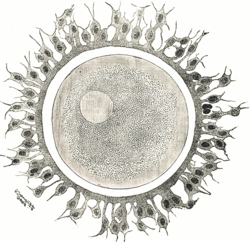Egg cells
| egg cell | |
|---|---|

A human ovum with corona radiata surrounding it
|
|
|
Anatomical terminology
[]
|
The egg cell, or ovum, is the female reproductive cell (gamete) in oogamous organisms. The egg cell is typically not capable of active movement, and it is much larger (visible to the naked eye) than the motile sperm cells. When egg and sperm fuse, a diploid cell (the zygote) is formed, which rapidly grows into a new organism.
While the non-mammalian animal egg was obvious, the doctrine ex ova omne vivum ("every living [animal comes from] an egg"), associated with William Harvey (1578-1657), was a rejection of spontaneous generation and preformationism as well as a bold assumption that mammals also reproduced via eggs. Karl Ernst von Baer discovered the mammalian ovum in 1827, and Edgar Allen discovered the human ovum in 1928. The fusion of spermatozoa with ova (of a starfish) was observed by Oskar Hertwig in 1876.
In animals, egg cells are also known as ova (singular ovum, from the Latin word meaning egg or egg cell). The term ovule is used for the young ovum of an animal. In vertebrates, ova are produced by female gonads (sexual glands) called ovaries and all of them are present at birth in mammals and mature via oogenesis.
In all mammals the ovum is fertilized inside the female body.
The human ova grow from primitive germ cells that are embedded in the substance of the ovaries. Each of them divides repeatedly to give secretions of the uterine glands, ultimately forming a .
...
Wikipedia
